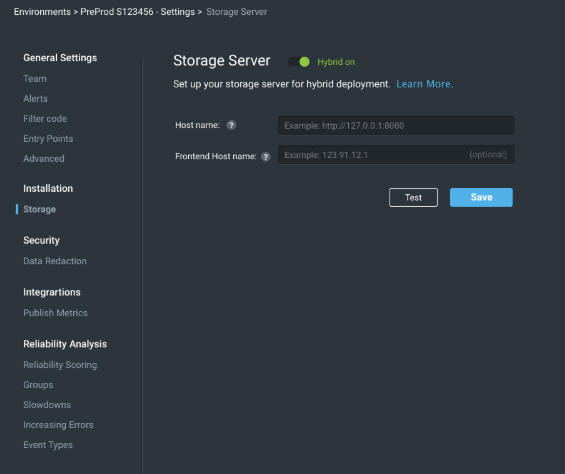Enable Connectivity over HTTP
This article describes how to configure the Storage Server (aka Variable Store) with HTTP.
To configure the Variable Store with HTTP:
- Open Settings by clicking Settings in the top right corner of the OverOps dashboard.
This opens the Settings dashboard for the environment you're in (you can see the environment in the upper left corner of the screen).
- Under the Installation tab, select Storage.
- Move the slider to the right to enable the Variable Store.
A warning will be displayed:
Variable Store warning
- To continue, click I understand the risk.
Turning on the Variable StoreSwitching the Variable Store on means you're moving your solution to a On-Premises Data model. To prevent you from switching the model inadvertently, you'll need to enter a valid host name and a valid front end host name, and to test the connectivity. If the server is not connected, and the test fails, you will not be able to save your changes.
The On-Premises Data Variable Store is enabled.

Variable Store Settings
- Set the Hostname (web application) and the Variable Store addresses (the hostname is the Variable Store URL).
NoteThe address format is: http://<IP_ADDRESS>:<PORT> (for example http://127.0.0.1:8080).
- If the browser is using a different IP address/hostname to access the server, select the Frontend hostname field.
- In your browser, allow unsecured scripts to load data by clicking Load unsafe scripts (the Frontend hostname is the Variable Store frontend URL).
- Test the connection by clicking Test. If the URL you entered for the hostname is invalid, you'll receive a message "No response from the host - check the host name.", which will remain displayed until the next successful test is run.
Valid HostnamesAll valid URLs can be passed as valid hostnames, for example:
- http://localhost:8080
- https://some-host-name
- https://<IP address>
- http://load-balancer/some-path
The appending
/storage/v1/diag/pingreturns anok. For example:
- http://localhost:8080/storage/v1/diag/ping
- https://some-host-name/storage/v1/diag/ping
- https://<IP address>/storage/v1/diag/ping
ImportantAfter enabling HTTPS, you will no longer need to enable unsecured scripts.
Updated 8 months ago
